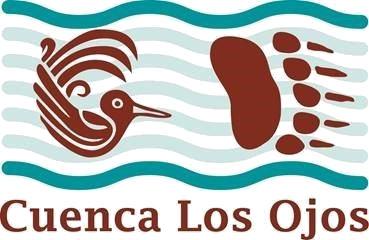Newsletter #8 - Bringing Back Water
Earlier this year, Jose Manuel and I had a chance to visit Pilar Pdersen at the Chaa Ranch in Texas. Under challenging circumstances, the Pedersons are trying to bring back the flow of water that used to supply the ranch.
Bringing Back Water
Pilar’s son Travis and his girlfriend Duha have built rock dams of considerable size in the last year with mixed results. Flooding in the high sierras has made it very difficult to control the speed of the water flow, but currently two-hundred and ten of the dams are still standing.
The ranch has been stocked with cattle since 1916. Goats were introduced in the 70’s, but some of these have gone feral and an estimated herd of over a thousand Aoudads (Barbary Sheep) have taken overgrazing the Sierras. The Aoudads are not native to the area. They were introduced by American soldiers stationed in Chad and the Barbary Coast during WWII having realized their potential as a game animal. Since 1993 when Pilar and her partner bought the ranch, there have been few domestic animals on the land, however, the Aoudads continue to graze every living plant in the Sierras.
Water that used go into vegetated high ground and collect in pools now sheets off the ridges as a result of this overgrazing. Piler explained:
“It felt like the land was going to be hot rocks shimmering in the heat”
Recently, a flood of water five feet high in the washes took out some of the dams. Nonetheless, Travis and Duha continue to put structures in the side canyons where the pressure from the water is not so great and also in the large washes only where it is possible to spread the water out over a large surface area and wet more land.
This young couple is motivated by a desire to heal the land. If they are able with limited resources to make positive changes on their land then I don’t see why more people are not doing the same.
Pilar says she has seen new grasses and plants appear in the last few years that she had not seen before. Jose Manuel and I also saw signs of regeneration. Pilar wrote to us recently and explained - "I walked the trincheras that you and Jose Manuel saw when I was at the ranch yesterday. Then Travis, Duha and I walked farther up the arroyo, past the place where we turned around. It had just rained. Where the trincheras are doing their jobs (most have filled in nicely) there is water pooled and even running in places. Above the little rock dam where there are no trincheras there is noticeably less standing water and no running water. Another proof that it works!" - Pilar
Travis and Duha are ecological heroes.
Boletin No.8
Trayendo de vuelta el agua: la experiencia de Texas
A principios de este año, José Manuel y yo tuvimos la oportunidad de visitar a Pilar Pdersen en el Rancho Chaa en el suroeste de Texas. Bajo circunstancias desafiantes, los Pederson están tratando de traer de vuelta el flujo de agua que solía abastecer el Rancho.
El hijo de Pilar, Travis y su novia Duha han construido presas de roca o trincheras de considerable tamaño en el último año con resultados mixtos. Las inundaciones en las altas sierras han hecho muy difícil controlar la velocidad del flujo de agua, pero actualmente 210 de las represas siguen en pie.
El Rancho fue pastoreado con ganado desde 1916. Las cabras fueron introducidas en los años 70, pero algunas de ellas se volvieron salvajes hay además una manada estimada de más de mil Aoudad (berberiscos) han tomado el pastoreo excesivo de las sierras. Desde 1993 cuando Pilar y su socio compraron el rancho, ha habido pocos animales domésticos en el terreno, sin embargo, los Aoudad continúan pastoreando todas las plantas vivas en las sierras.
El agua que anteriormente regaba la vegetación en la parte alta de la sierra y era colectada en posas en los arroyos, ahora erosiona al correr de la parte alta del terreno a causa del suelo desnudo por sobrepastoreo. Pilar explicó:
- "se siente como la tierra se converte en rocas calientes brillando en el calor".
Recientemente, una inundación de agua de cinco pies de alto (más de un metro y medio) en los arroyos sacó algunas de las trincheras. Sin embargo, Travis y Duha continúan colocando estructuras en los cañones laterales donde la presión del agua no es tan grande y también en los grandes arroyos sólo donde es posible esparcir el agua sobre una gran superficie y mojar más tierra.
Esta joven pareja está motivada por el deseo de sanar o restaurar la tierra. Si son capaces con recursos limitados para hacer cambios positivos en su tierra, entonces no veo por qué más gente no está haciendo lo mismo.
Pilar dice que ha visto nuevos pastos y plantas en los últimos años que no había visto antes. José Manuel y yo también vimos señales de regeneración.
Pilar nos escribió recientemente y explicó -"caminé las trincheras que tú y José Manuel vieron cuando yo estuve en el Rancho ayer. Luego Travis, Duha y yo caminamos más allá de donde nos regresamos cuando ustedes nos visitaron. Acababa de llover. Donde hay trincheras, estas están haciendo su trabajo (la mayoría se han llenado bien) hay agua encharcada e incluso corriendo en estos lugares. Aguas arriba donde no hay trincheras hay notablemente menos agua estancada y sin agua corriente. ¡Otra prueba de que funciona! "- Pilar.
Travis y Duha son realmente héroes ecológicos.
======================================================
(https://cuencalosojos.org/)





